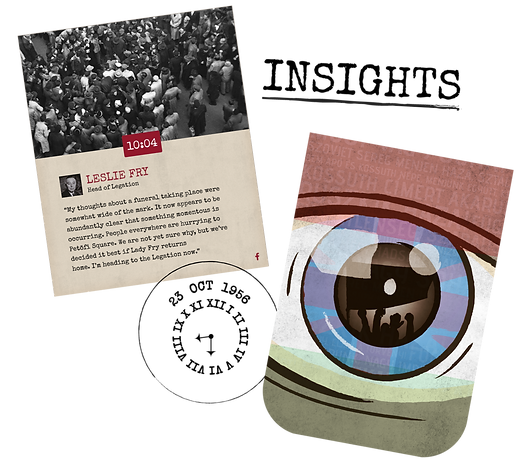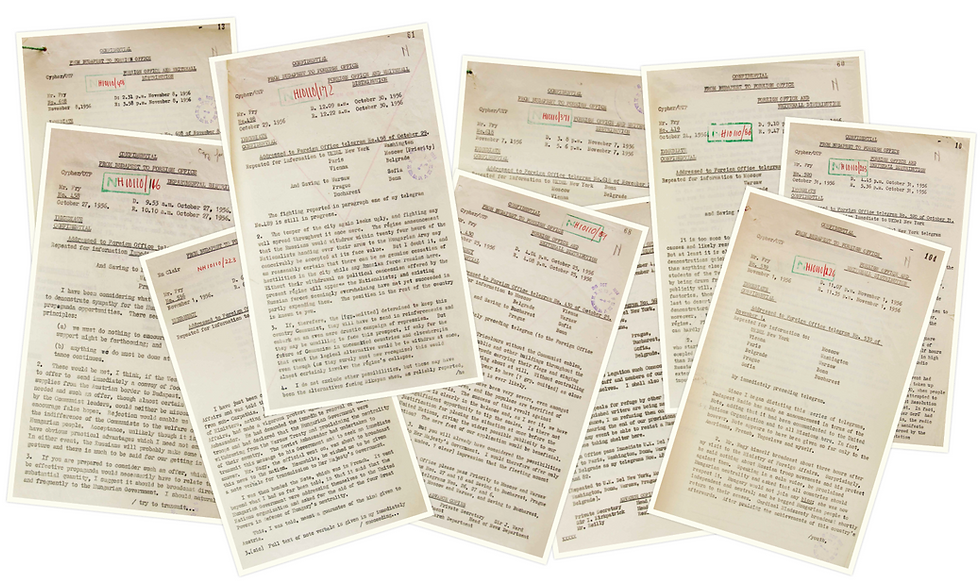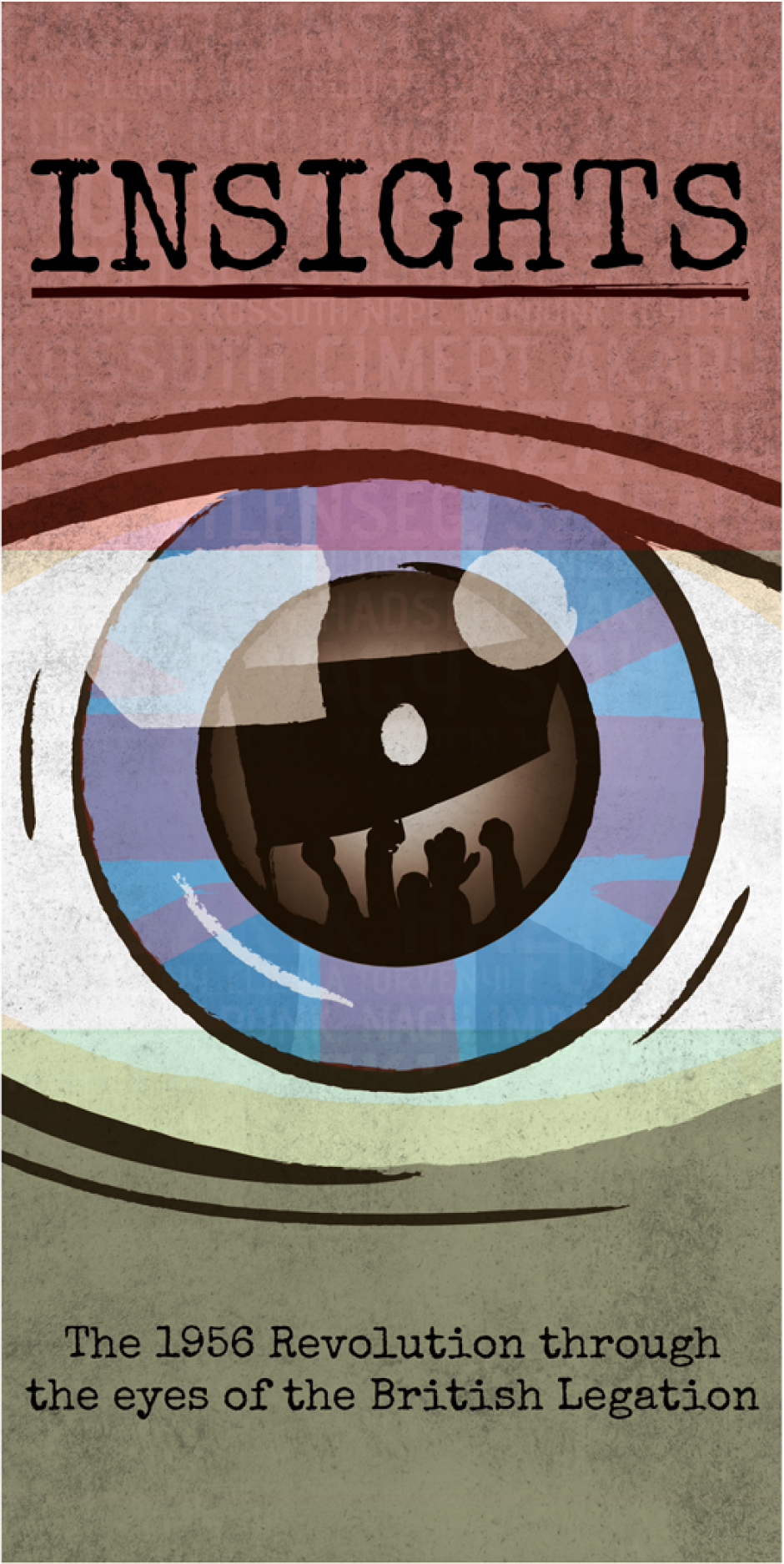The 1956 Revolution Through the Eyes of the British Legation in Budapest
The British Embassy Budapest

ROLE: ux/ui design, graphic design, creative concept development
TOOLS: Paper & pencil, Adobe Illustrator, Adobe Photoshop, Adobe InDesign
DURATION: 3.5 very intense weeks
Transforming diplomatic archives into living history.
- An award-winning approach -
In 2016, the British Embassy in Budapest prepared to commemorate the 60th anniversary of Hungary's 1956 revolution. They possessed an extraordinary treasure trove of historical materials—never-before-released telegrams, communications, and records from their time as the British Legation during the revolution, documenting their unique role in informing the West and assisting British citizens caught in the turmoil.
Our team at Chili Creative Solutions, the digital agency I co-founded, was chosen to help transform these valuable historical documents into a modern digital experience.
Working closely with a dedicated Embassy team and collaborating with Gareth Hutchins, a brilliant British copywriter I've worked with several times, we took on the challenge of bringing these diplomatic archives to life for a new generation. Our innovative approach ultimately earned the British Embassy Budapest recognition among all British Embassies and Consulates worldwide, winning an internal award for this unique commemoration.

The Task
The challenge was multifaceted. While the 1956 Revolution is extensively documented in Hungarian history, creating another standard historical presentation wouldn't suffice. The Embassy needed a commemoration that would stand out among numerous existing ones, appealing to diverse audiences, especially young students. The presentation needed to handle historical documents in an engaging, modern way while honoring the dignity of the events. Most importantly, we needed to transform complex diplomatic communications into compelling narratives that would resonate with today's audiences.
Adding to the complexity, we needed to work with various types of historical materials—diplomatic telegrams, video recordings, audio files, and personal diary entries—each requiring different approaches to digital storytelling.
The project timeline meant another layer of intensity. With just 3.5 weeks to deliver, we faced an extraordinarily tight schedule. Within this compressed timeframe, our team needed to review and analyse extensive historical materials, develop a creative concept, and create content in both English and Hungarian. We were responsible for designing and building a responsive bilingual website, producing all supporting print materials, and completing thorough testing—all while maintaining the highest standards of historical accuracy and user experience.
This ambitious timeline, combined with the project's complexity and historical significance, demanded exceptional efficiency and dedication from our team.
The Solution
Our breakthrough came from an unexpected parallel between past and present communication styles. Sir Leslie Fry's, Head of Legation's frequent telegrams to London, sometimes sent multiple times daily, created an almost real-time account of unfolding events—just like today's social media updates. These detailed reports, combined with various historical materials and evidence, allowed us to construct a precise timeline of events, from the earliest signs of unrest through the revolution itself.
The pieces of information came from specific characters within the Legation, creating distinct voices and perspectives. This insight led to our innovative solution: reimagining these historical accounts as if they were being shared on the British Legation's social media feed in 2016. We titled the project "Insights," reflecting both the unique insider perspective and the deep understanding it offered of this historical moment. The format would feel instantly familiar to young audiences while maintaining historical accuracy.
The resulting website presented the 1956 Revolution through a carefully curated feed of 'posts' from Legation staff members, each sharing their real-time observations through period photographs, videos, audio recordings, and telegram excerpts. This chronological storytelling approach allowed visitors to experience history unfolding moment by moment, offering both a comprehensive overview of events and intimate insights into how the Legation staff worked to assist both British citizens and Hungarians during this crucial period.

High-fidelity prototype of the Insights site created for the British Embassy Budapest to commemorate the 1956 revolution in Hungary on its 60th anniversary with a socila media feed-like timeline of the events unfolding.
The Process
Step 1 Discovery & research
Faced with our ambitious timeline, we needed to approach research strategically. Fortunately, the Embassy's dedicated team included their social media manager, who proved invaluable in bridging the gap between our creative agency's work style and the Embassy's more traditional processes. The Embassy team demonstrated exceptional flexibility, accommodating additional meetings and brainstorming sessions despite our tight schedule.
The research materials were extensive and varied. We received a compiled book of the Head of Legation's telegrams, along with access to the original documents for design inspiration. Our team divided these materials among ourselves, rotating through different types of content to ensure everyone gained a comprehensive understanding while maintaining efficiency.
One of the most valuable research experiences was our guided tour of the old prestigious Embassy building. Walking through the actual locations mentioned in telegrams and interviews brought the historical accounts to life. This physical connection to the space, combined with detailed historical context provided by the Embassy colleagues, proved instrumental in sparking creative ideas.
We balanced collaborative sessions with independent research time, allowing team members to process information and develop initial concepts before coming together for group ideation. This approach helped us maximise our limited time while ensuring thorough understanding of the historical material.

Some of the original telegrams sent by Sir Leslie Fry, the Head of Legation in Budapest to London.
Step 2 Ideation
- From Historical Documents to Digital Storytelling -
Our main brainstorming session proved to be a catalyst for innovation. Having thoroughly reviewed the historical materials, each team member arrived with well-developed ideas, making the conceptual development both productive and engaging. The creative energy was palpable as ideas built upon each other, evolving into stronger concepts with each iteration.
The core concept emerged naturally: a website that would present historical events through the lens of modern social media, making the content instantly relatable to contemporary audiences. But our creative scope expanded when the Embassy shared plans for a commemorative event aimed at political figures, scheduled for the revolution's anniversary date.
This led us to develop an integrated approach that would bridge digital and physical experiences. We conceptualized an exhibition that would guide visitors through ten themed locations within a single space, each telling a crucial part of the story. While the Embassy team focused on sourcing period-appropriate furniture and artifacts, I was responsible for creating the visual narrative through ten location-specific posters, alongside the website design and additional communication materials including flyers and invitations.
With our comprehensive concept firmly established, each team member returned to their workspace, ready to bring their piece of this multilayered commemoration to life.

A vector map of Budapest I created to show the most important locations of the events in the capital. A map of Budapest from 1956 served as the basis of this one.
Step 3 Design
- Bringing History in The Digital Age -
Our design phase unfolded on parallel tracks, with Gareth crafting the narrative content while I developed the visual identity for both the website and the commemoration event. We maintained constant communication with each other and the Embassy team, ensuring alignment at every step through regular check-ins and feedback sessions.
Visual Identity The core visual concept emerged from a powerful historical symbol—the Hungarian flag with its communist crest cut out, an iconic image of the 1956 revolution. I designed our main visual element, an eye peering through this hole, representing the British Legation's perspective on unfolding events. This concept resonated immediately with stakeholders, requiring only minor refinements.

The main visual of the commemoration event and website.
This image with the eye looking through the hole on the Hungarian flag was used in every communication material from posters through social media posts to invitation and flyers.
Digital Experience The website design needed to balance historical authenticity with modern usability. I created a timeline interface that evoked the texture of aged diplomatic documents, setting telegrams against a weathered cardboard background. Ruby red accents marked dates and times, a choice that both provided visual hierarchy and subtly referenced the revolution's human cost. A carefully selected typewriter font completed the period aesthetic while maintaining readability.
Designed to mirror a social media feed, the Insights home page transforms historical telegrams and materials into real-time 'posts' from British Legation staff. Visitors scroll through a chronological timeline of events, experiencing history through photographs, videos, audio recordings, and firsthand accounts, culminating in the revolution's aftermath. This high-fidelity prototype shows the interface design; the live site featured a much longer timeline populated with extensive historical content.

Responsive Design After finalising the desktop experience, I adapted the design for tablet and smartphone screens, ensuring that the historical narrative remained engaging across all devices. This work was then passed to Joe, my co-founder and lead developer, known for his uncompromising attention to detail in implementation.


Exhibition Materials With the digital platform underway, I turned to designing ten location-specific posters for the physical exhibition, along with supporting materials including invitations and flyers. Each piece adhered to our established design framework, ensuring visual consistency across all touchpoints. Throughout this process, the Embassy team continued providing crucial content and feedback, helping us maintain both historical accuracy and our ambitious timeline.
The effectiveness of our earlier planning and brainstorming sessions became evident as both the narrative and visual elements required minimal revision, allowing us to maintain our demanding schedule.



Some posters from the exhibition. The size of each poster was 70x100cm. All together we created 10 posters for the different locations of the physical exhibition held on 20th October 2016.

The Invitation the British Embassy sent out for the Exhibition.
Step 4 Development hand-off
- Racing against time -
The development phase was particularly critical given our tight timeline. Technology can be unpredictable, so having our development team involved from the project's inception proved crucial. This early collaboration helped ensure our creative ideas remained technically feasible—though as Joe often reminded us, "nothing is impossible, it's only a matter of money." With no time for extensive iterations, this technical oversight kept our ambitious vision grounded in reality.
Parallel Development To maximise efficiency, Joe began backend development as soon as we aligned on functionality, working from my initial hand-drawn structure sketches. The development team didn't wait for complete designs, instead implementing the desktop version while tablet and mobile designs were still in progress. This parallel workflow became essential as October 23rd approached quickly.
Content Management Once the backend was operational, we conducted a brief training session with the Embassy team, enabling them to begin uploading their extensive content while development continued. This parallel content population saved valuable time in our race to launch.
Design Implementation Watching designs come to life in the browser is always a rewarding moment, though in this project it was just another milestone in our sprint to completion. I meticulously reviewed the implementation using Inspector, checking for pixel-perfect execution. Thanks to Joe's understanding of my attention to detail, the implementation met our high standards without requiring extensive revisions.
Final Push The final phase became an all-hands effort, with team members helping test functionality and upload content. We launched just within our deadline, delivering a platform that married historical content with modern technology. The successful launch, despite our challenging timeline, demonstrated what's possible when a team aligns completely behind a shared vision.
Reflection
- Where History Met Innovation -
While this project pushed our limits with its ambitious timeline, it stands out as one of my most rewarding professional experiences. It exemplifies why I love what I do—the opportunity to dive deep into fascinating subjects while creating meaningful digital experiences. Immersing ourselves in historical documents, from diplomatic telegrams to personal interviews, offered unique insights into a pivotal moment in history, while watching our diverse team work in perfect synchronization toward a common goal was truly inspiring.
The exhibition proved to be a remarkable success, generating such interest that the Embassy faced significant pressure to extend its run to the general public, though security protocols ultimately prevented this expansion.
The project's recognition—winning an internal award among all British Embassies worldwide—reflects the exceptional dedication and professionalism of everyone involved, from our creative team to the Embassy staff. This achievement not only validates our innovative approach to historical storytelling but also demonstrates how technology can bridge past and present in meaningful ways.
“The British Embassy commissioned Chili’s team to produce the creative design and website for our project to commemorate colleagues who worked in Budapest during the 1956 Revolution. The team responded with enthusiasm, proactivity and a determination to really understand our needs. They went the extra mile to ensure an excellent end product within a very challenging timetable.”
- Ben Luckock, Head of Policy Team, British Embassy Budapest